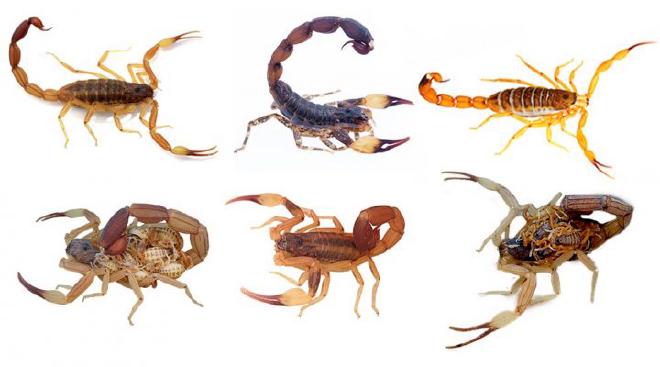

“Previous contributions to the problem of the distribution of scorpion species of public health importance have focused on specific areas, generally cities or provinces. This issue must be addressed in a broad and comprehensive manner, since the species studied have distributions that exceed national borders, and in many cases are advancing across new frontiers. The information our work provides is useful for developing control strategies,” says Andrés Ojanguren-Affilastro, study leader and CONICET researcher at the Bernardino Rivadavia Argentine Museum of Natural Sciences (MACNBR, CONICET).
Scorpion species studied #
In the study led by Ojanguren-Affilastro and with CONICET doctoral fellow Alexis Emanuel Barrios-Montivero as first author, the expansion of medically important scorpions of the genus Tityus in southern South America was reviewed: Tityus bahiensis, Tityus carrilloi, Tityus confluens, Tityus costatus, Tityus serrulatus and Tityus trivittatus which, due to their synanthropic capacities, that is, their great adaptability to urban environments, are considered invasive species.

Three of the species analyzed, Tityus carrilloi, Tityus confluens and Tityus serrulatus, have a greater distribution capacity because they are facultative parthenogenetic; “this means that females can reproduce asexually without the need for males, which makes them excellent colonizers of new urban areas,” explains Barrios-Montivero, who is a member of the Department of Biology of the Faculty of Exact and Natural Sciences at University of Catamarca.
Tityus serrulatus, originally from northern Brazil, has also advanced southward, reaching the Rio Grande do Sul region and the border with Argentina and Paraguay. “In northeastern Argentina, Paraguay, and eastern Bolivia, it is very likely that Tityus serrulatus will soon enter from Brazil, if it is not already present and undersampled,” says Ojanguren-Affilastro.
In countries such as Chile and Uruguay, which do not yet have scorpion problems, Tityus confluens and Tityus carrilloi will almost certainly become established in the near future, the study indicates.
On the other hand, the three non-parthenogenetic species, Tityus bahiensis, Tityus costatus and Tityus trivittatus,are only settled in cities that were within their original distribution area and did not advance into new regions.
“The projection for the future, to 2070, indicates an even greater increase in this problem, with greater overlap of these species in cities and an increase in their distribution ranges, particularly towards the south and east,” Ojanguren-Affilastro points out.
Phytosanitary border controls #
Synanthropic scorpion species can only spread to new urbanized areas outside their natural range through involuntary passive transport mediated by human activities, usually along with merchandise. “This is why it is suggested as a primary control measure to include all synanthropic scorpion species in southern South America within the scope of border phytosanitary controls, particularly in countries without scorpion problems such as Chile and Uruguay,” states the CONICET researcher.
Once these scorpions have established themselves in an area, they can no longer be eradicated. They generally settle underground in cities, in sewers, basements, and subway tunnels, among other places. “In these cases, their population can only be reduced with highly targeted and highly controlled chemical controls, to prevent them from dispersing the scorpions instead of eliminating them. As a mitigation measure, the use of physical barriers to prevent their entry into homes and vulnerable areas, such as schools and health centers, is suggested,” says the CONICET specialist.
After been stung #
If stung, simply clean the affected area and go to a health center as soon as possible. If possible, take the dead scorpion with you so that medical personnel can identify it and assess whether it’s a dangerous species, explains Ojanguren-Affilastro.
“In Argentina, the Malbrán Institute produces antivenom for the dangerous Tityus species present in the country. This antivenom is distributed in health centers and is highly effective, which is reflected in the low number of deaths from scorpionism compared to the large number of reported stings. Antivenom is applied only if the patient’s symptoms require it, since not all stings require treatment, even if they are caused by a potentially dangerous species,” the CONICET scientist points out. He concludes: “Our work provides information not only about the present but also about future scenarios of scorpionism, which facilitates decision-making and measures to address a problem of importance to the public health of our country and the region.”
Argentine researcher Pablo Ariel Martínez, from the Integrative Biodiversity Research Laboratory at the Federal University of Sergipe in Brazil, also participated in the work.
-
The paper The Ongoing Expansion of the Medically Important Scorpions in Southern South America (La continua expansión de los escorpiones de importancia médica en el sur de Sudamérica), was published in the EcoHealth journal. Authors: Alexis Emanuel Barrios-Montivero, Pablo Ariel Martínez & Andrés Alejandro Ojanguren-Affilastro
-
The article Especialistas del CONICET lideraron el primer estudio regional sobre la expansión de escorpiones de importancia sanitaria en el sur de Sudamérica, signed by Bruno Geller, was published in the CONICET’s news section website.
Contact [Notaspampeanas](mailto: notaspampeanas@gmail.com)

